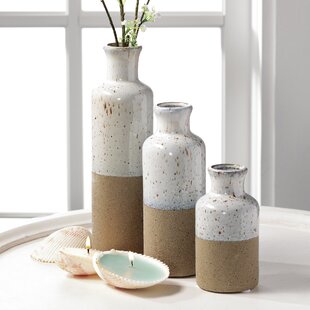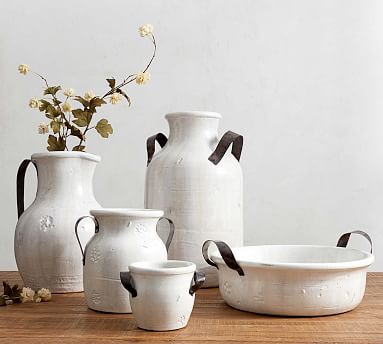From Clay to Art: Handcrafted Vases That Showcase the Beauty of Handiwork
This write-up examines the virtuosity as well as appeal of handmade flower holders, concentrating on the procedure of transforming clay right into art.
It checks out the strategies employed in creating these vases and also stresses the party of virtuosity that handmade vases represent.
Via a goal and also impersonal lens, this write-up intends to clarify the craftsmanship and also skill associated with the creation of handmade vases, highlighting their ability to display the appeal of workmanship.
The Artistry of Handcrafted Vases
The virtuosity of handcrafted flower holders appears in their detailed layouts and thorough craftsmanship (Vase). These vases are not just utilitarian objects however are artworks that present the skill and imagination of the artisans that create them
The intricate designs located on handcrafted flower holders showcase the degree of detail and precision that goes right into their development. Each flower holder is meticulously crafted, with every curve, line, as well as pattern thoughtfully considered to boost its visual charm. The craftsmens utilize various methods such as carving, molding, and also painting to bring their artistic vision to life.
Moreover, the meticulous workmanship included in making handcrafted vases is remarkable. These vases are frequently made from clay, which calls for a delicate touch and specific shaping. The artisans skillfully control the clay, using simply the correct amount of stress to create the preferred kind as well as dimension. They take notice of every minute detail, making certain that the surface area is remarkable and also smooth. Additionally, the firing and glazing processes need knowledge to accomplish the preferred finish, texture, and color.
Discovering the Clay-to-Art Refine

When it comes to handmade flower holders, the trip from clay to art starts with the selection of the raw material. Clay, understood for its malleability and also capability to maintain form when terminated, is the main product utilized.
The clay is after that prepared by getting rid of impurities as well as excess dampness, making certain a smooth and convenient uniformity. When the clay prepares, it is formed right into the wanted kind making use of numerous strategies such as tossing, curling, or piece structure - Vase. The artisan very carefully shapes the clay, focusing on details such as surface area, percentage, as well as balance texture
After forming, the flower holder is delegated dry slowly, allowing it to stabilize and set. Once dry, it undergoes the shooting process, where it is subjected to heats in a kiln. This firing procedure not just enhances the vase however likewise transforms the clay right into a irreversible and also resilient product.
Revealing the Charm of Creation
Revealing the appeal of the artisan's workmanship entails a cautious as well as thorough process that highlights the ability, patience, and precision required to produce a handmade masterpiece.
The art of workmanship is a time-honored practice that has been passed down with generations, preserving the essence of social heritage.
The artisan starts by very carefully picking the raw materials, making sure that they are of the best quality and also suitable for the designated layout. The clay is then prepared, undergoing a series of actions such as look at here now rub, wedging, and also shaping to achieve the preferred uniformity and eliminate any air bubbles or impurities.

After the shaping is full, the vase is carefully dried to get rid of any type of continuing to be dampness, guaranteeing its durability and security. The last step involves firing you could try this out the vase in a kiln, which not just strengthens the clay however likewise conveys a distinct personality to the ended up item.
The result is a handcrafted vase that embodies the skill, commitment, and creative vision of the craftsmen, showcasing the beauty of their craftsmanship.
Strategies Behind Handmade Vases
One important element of producing handmade vases includes the cautious selection and prep work of raw products. The selection of raw products is important as it identifies the final outcome and also top quality of the flower holder.
When the clay is prepared, it can be shaped using numerous strategies such as wheel throwing or hand structure. Wheel throwing involves rotating the clay on a pottery wheel while forming it with hands and also devices. Hand building strategies, on the other hand, entail manually forming the clay utilizing coils, pieces, or pinching.
After the vase is formed, it is entrusted to dry slowly to avoid breaking. As soon as dried out, the vase undertakes the shooting process in a kiln, where it is revealed to heats to change the clay as well as solidify right into a ceramic material. The shooting process additionally allows the application of glazes, which include color and also supply an ornamental finish to the flower holder.
Generally, the careful choice and prep work of resources are essential action in the production of handcrafted vases, guaranteeing their high quality and aesthetic appeal.
Handmade Vases: A Party of Artistry
The workmanship behind handmade vases mirrors the skill and also creativity of the craftsmens involved in their development. Hand-made vases are not just practical things; review they are artworks that display the talent and also commitment of the craftsmen. These artisans have a phenomenal degree of skill and also know-how, honed through years of method and also experience. The procedure of producing a hand-made vase involves different phases, each calling for meticulous interest to information and a deep understanding of the product being made use of.
The very first step in crafting a handcrafted vase is the selection of the clay. Artisans choose clay that is of high quality and also suitable for the desired shape and layout. As soon as the clay is picked, it is meticulously prepared by removing impurities and working it to accomplish the desired consistency.
The shaping of the flower holder is done by hand, using conventional techniques such as coiling, pinching, or throwing on a potter's wheel. This requires a constant hand and also a keen eye for percentage as well as balance. The craftsmens use their fingers, tools, and even their breath to shape the clay into the wanted kind.
After the flower holder is shaped, it undergoes a process of drying and also shooting in a kiln. This shooting process transforms the clay right into a sturdy ceramic material. The artisans very carefully check the temperature and duration of the firing to guarantee that the flower holder achieves the desired stamina and look.
As soon as the vase is fired, it can be enhanced making use of different methods such as painting, sculpting, or glazing. These ornamental elements add charm as well as originality to the vase, boosting its creative value.
